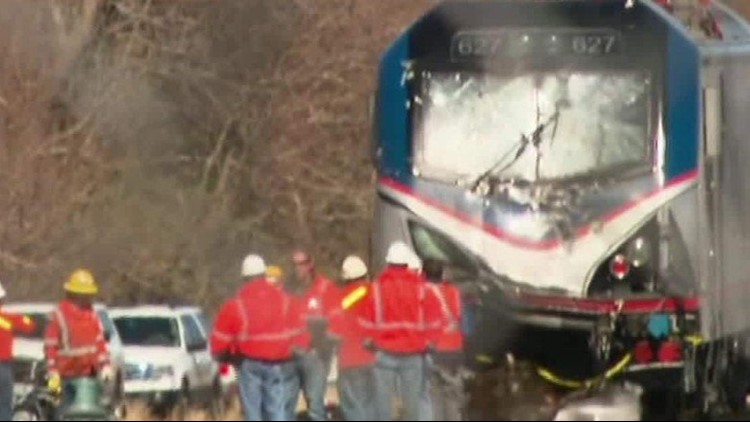CHESTER, Pennsylvania — Strong evidence suggests two Amtrak construction workers killed in a train crash made a “colossal” mistake by being on the wrong line, a source close to the investigation said Monday.
The crash occurred Sunday morning when an Amtrak train carrying 341 people slammed into a backhoe on the track near Philadelphia, killing the two construction workers.
Another 37 people were injured and treated for minor injuries, a Chester city spokeswoman said.
Investigators will try to determine why the construction workers may have been on the wrong line, which was considered “active,” the source said.
Construction work on an active rail line isn’t uncommon, especially on Sundays, experts say.
But this fatal crash, which involved a large piece of equipment on a live track, “should have never happened,” said Allan Zarembski, director of the Railroad Engineering and Safety Program at the University of Delaware.
He said he was stunned to learn the construction workers were Amtrak employees and not contractors.
“The fact that there was a backhoe manned by Amtrak personnel — that’s an even higher level of concern,” he said.
When construction on a live track is allowed
Zarembski said construction work on active tracks should only happen if the workers are using small or hand-held equipment.
In those situations, a company dispatcher is supposed to notify train engineers of work crews ahead so they can slow down or stop the train in advance.
As an added safety measure, crews using small equipment should have at least one “flag man” farther up on the track, who would use a loud air horn to alert workers of oncoming trains.
But workers using a backhoe should never be allowed on an active track, under any circumstances, Zarembski said.
When using large equipment, “the track has to be taken out of service,” he said.
“They should have known better than to be on that track,” Zarembski said. “Maybe what happened was they were given permission to go on (an inactive) track, and maybe they made a mistake and went on the wrong track.”
When other tracks are nearby
Images of the crash site show at least two other rail lines close to the train’s track. So what if the workers had permission to work on an inactive line, but the equipment carried over to an active line?
While such scenarios are possible, “these things are very rare,” Zarembski said. And workers getting killed in adjacent line accidents are also uncommon.
Ultimately, he said, it’s up to the crews to be aware of their surroundings and make sure large equipment doesn’t drift onto the path of oncoming trains.
And if the workers were on the wrong line to begin with, “human error can sometimes override most safety systems.”
Decades of experience
But the two construction workers had plenty of experience. One had worked for Amtrak for about 40 years, the other for about 20 years, said U.S. Rep. Robert Brady, D-Pennsylvania. Brady said he spoke with Amtrak when he toured the scene Sunday.
He said the workers were performing routine maintenance at the time.
Amtrak has a 12-step procedure for construction work on rail lines, the source close to the investigation said. The investigation will determine whether a mistake was made in that procedure, the source said.
‘Like a nightmare’
Passenger Cristine Starke said the crash felt like an explosion.
“I think we crumbled under the pressure,” she said. “There’s a hole, and it looks as if the train bent, and that was about 2 feet in front of me. It felt like an explosion. I ended up on the ground.”
The debris was so thick that it looked like snow on the windows, she said.
Even before the crash, Glenn Hills said he knew something was wrong.
He didn’t see the backhoe that lay ahead on the track. But “there was a lot of debris in the track, and we started driving through that,” the Brooklyn resident said. “There was a lot of gravel noise.”
The mess wasn’t confined to the track, Hills said.
“I looked outside, and it looked like we were in this brown cloud,” he said, speculating that the dustiness came from construction or high winds. “We were rolling into this storm, this sandstorm.”
That’s when passengers started panicking. A woman started screaming prayers. Then the train slammed into the backhoe.
“It feels like a nightmare,” he said. “It felt like this is that experience that I’ve feared in the past.”
‘Positive train control’ installed
The crash came less than a month after an Amtrak train traveling from Chicago to Los Angeles derailed in Kansas, injuring 32 people.
It also came almost a year after another Amtrak derailment in Philadelphia, one that left eight people dead and more than 200 injured.
After that disaster. Amtrak announced it activated “positive train control” on virtually all its rail lines from New York to Washington. The technology is designed to match train speed with track conditions.
For example, if a train is going too fast for a curve or an upcoming work zone, the PTC system would alert the engineers and, if necessary, slow the train down.
But in the case of Sunday’s accident, PTC might not have mattered.
“What normally happens is the dispatcher gives the maintenance people permission to work in work zone, then the dispatcher enters it into the system as a work zone. In that case, PTC can alert the train,” Zarembski said.
But if workers go on the wrong track, “there’s no way of knowing that.”



